Patrick Kane and Jonathan Toews don’t play on the same line. That’s been the doctrine largely followed by coach Joel Quenneville and his staff en route to three Stanley Cups since 2010 in this era of Chicago Blackhawks brilliance.
Separating their two superstar forwards has provided depth and balance through the club’s top-six and made it difficult for opponents to match up, forcing them to choose whether to deploy their top defensive pairings and preferred forward lines against Toews’ unit or Kane’s. The strategy of placing one elite player on each of the top two lines has formed the basis of the Blackhawks’ powerful offense that’s carried them through their championship years.
After a 2017-18 during which both players weren’t nearly as good as they’ve been during their brilliant careers, however, Quenneville and co. might want to reconsider. It’s possible that the best future for the dynamic duo as they enter their 30s involves more time together on a formidable top line that could be extremely productive regardless of opponents’ attempts to stop it.
Though some will likely view such a suggestion as a desperation move, it’s undeniable that even teams possessing a championship core must evolve and adjust as players age, the rest of their league catches up, personnel changes happen, etc. So it’s worth entertaining the idea that the time has come for the Blackhawks’ top forward talents to team up, at least on a trial basis, to start 2018-19.
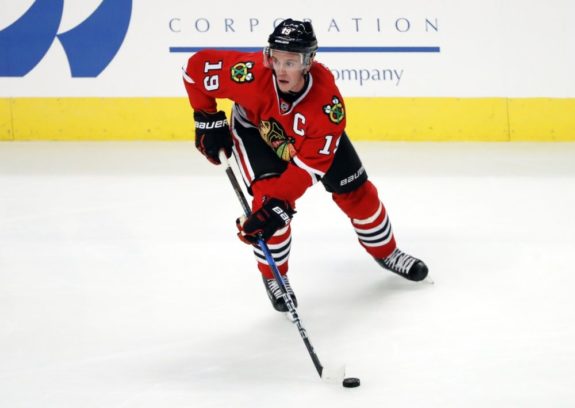
To say desperation would play no role in such a move wouldn’t be accurate, of course. In fact, management has already acted once on that emotion, in that case to poor results. Toews’ effectiveness declined enough over 2015-16 and 2016-17—both of them with erstwhile linemate Brandon Saad gone to the Columbus Blue Jackets in a June 2015 salary dump—that general manager Stan Bowman and the front office were alarmed. Determined to jumpstart the captain’s game, they reacquired Saad for sniper Artemi Panarin in a multi-player trade June 23, 2017.
That transaction has rippled through the team. Toews wasn’t any better in 2017-18, recording career-lows with 20 goals and 52 points, and the removal of Panarin also hurt his linemate Kane’s productivity. Though Kane had 76 points, that total was 13 fewer than the previous season and represented his second consecutive season of declining point totals.
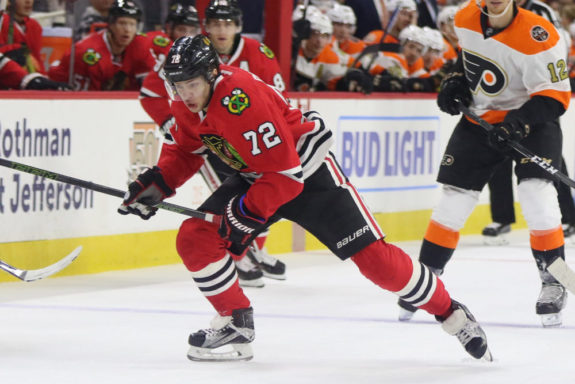
Panarin, who totaled 61 goals and 90 assists over the previous two seasons while teamed mostly with Kane (106 points in 2015-16, 89 in 2016-17) and Artem Anisimov on a terrific forward unit, continued his dynamic ways with the Blue Jackets in 2017-18, scoring 27 goals and recording 55 assists.
Statistics Show Kane-Toews Pairing Has Promise
So if management’s priority is resurrecting/maintaining the elite play of Toews and Kane from the not-too-long-ago Cup years, some creativity might be in order. The ill-fated Saad-Panarin trade might be wholly to blame, but more likely, it’s a significant contributing factor in the dropoff. The two Hawks stars are aging, and playing them together could be the way to get as much as possible out of them in the second half of their careers.
The 29-year-old Kane may not have the same jump in his legs that used to allow him to carry whatever linemates he was given; Toews, 30, might not be as quick or elusive as he once was. Could combining their skills resuscitate their usual levels of production?
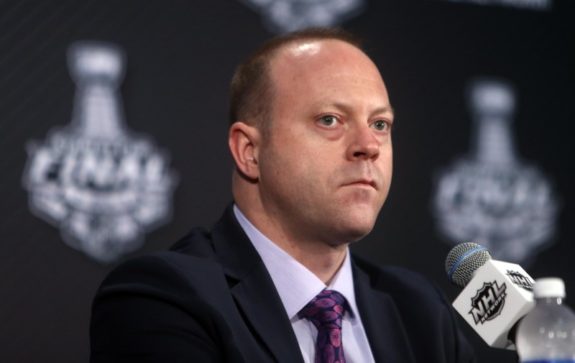
At first glance, advanced statistics on the topic from last season don’t appear to tell a great story. At 5-on-5, Toews posted a scoring-chances-for percentage of 56.74 playing without Kane, with the Blackhawks generating 111 more chances than their opponents when Toews was on the ice and Kane was on the bench. With Toews and Kane on together, that number dropped to 52.09, with only 11 more chances that the other team (the caveat being that it was a very small sample size, as the duo took the ice together at 5-on-5 for only 235 minutes and 15 seconds last season).
A closer look, however, reveals a much more encouraging trend: Kane and Toews produced a high-danger-chances-for percentage of 58.04, with 65 HDCF generated for the Blackhawks to 47 for their opponents. That means that the two franchise players were often a handful for opposing defenses when playing together, creating considerably more high-percentage scoring opportunities that the other team when on the same line at 5 on 5.
The initial thought in this experiment would be to create a Toews-Kane-Saad unit, which Quenneville tried at times last season. Though Kane finally struggled without a consistent linemate in Panarin last season, he’s always been the one more adaptable to rotating linemates, and perhaps Toews and Saad finally do regain their chemistry after the rough first reunion season. Saad, in theory, would also complement the more skilled Toews and Kane with his work in the corners and in front of the net, allowing the two stars to freewheel more offensively.
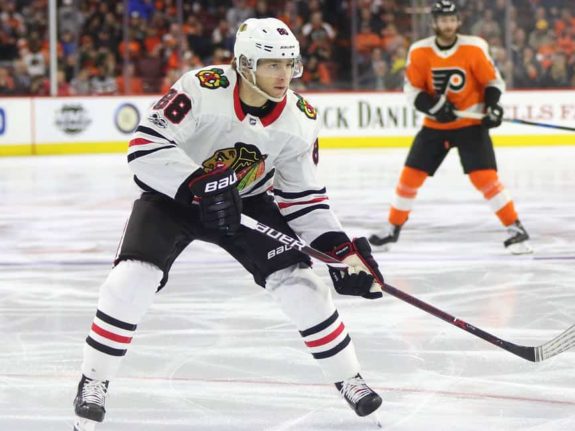
A look at a potential Saad-Toews-Kane line again represents a small sample size, but it exhibits some promise: a 52.63 SCF percentage over 170:42 at 5 on 5, with 10 more chances generated than opponents did. The HDCF number of 53.57 is similarly intriguing, with the trio earning six more high-percentage chances than opponents did at 5-on-5.
What also has to be factored in, at least in part, is the need for Kane, Toews and Saad (or another linemate) to develop chemistry. Toews and Kane played together consistently early in their careers that began in 2007-08, but not much since during their 11 years in the NHL. Therefore, some patience would likely be required to see if the duo can again thrive together over the long haul, and who the best third member of such a line might turn out to be.
Critics of the strategy to unite Toews and Kane on the top line will point out that no matter how effective that situation turns out, the net result might be a wash, as the club would be robbing depth from the second and third lines by putting the two stars together. It’s certainly possible that the Blackhawks would suffer from a crucial lack of productivity from those units without Kane or Toews on separate lines, but unless this experiment is tried on an extended basis, it’s nothing more than an assumption that it would happen.
Schmaltz, Anisimov, DeBrincat Would Need to Step Up
For this to work, second-line center Nick Schmaltz, who leapt from six goals as a rookie to 21 in 2017-18, will need to continue his ascendance. The Blackhawks would also require more from Anisimov, who would have to assume more responsibility and productivity from the third line—if he’s not dealt. Talented but mercurial throughout his nine full seasons, Anisimov could wilt under that added pressure—or respond well to it. With Kane gone from his wing and less defensive attention on his line as a result, Anisimov would be in position to make opponents pay for disregarding the Blackhawks’ other lines, lessening the need to break up Kane and Toews if they are powering a dangerous top unit.
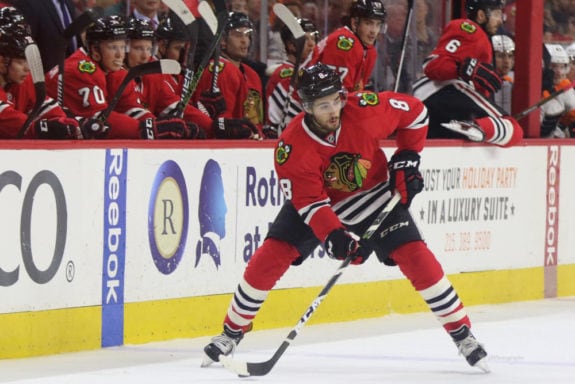
Alex DeBrincat, who topped the Hawks with 28 goals last season as a rookie, was effective when playing on Anisimov’s line. That duo posted a 58.02 SCF percentage over 141:04, and there would certainly be time for experimentation with other potential linemates in training camp and the early season.
Any strategy that has worked in the past can at some point become counterproductive, and it’s possible that the Blackhawks’ offensive philosophy of steadfastly keeping Kane and Toews apart could be at that point. The duo played on separate lines last season and that certainly didn’t help Chicago’s once-dangerous offense, with the club tying for 21st in the league with 2.78 goals per game. With the Blackhawks’ depth no longer what it was during the Cup years, the strategy might no longer be aggressive enough, more reactive and knee-jerk than crafted for the current realities of the roster.
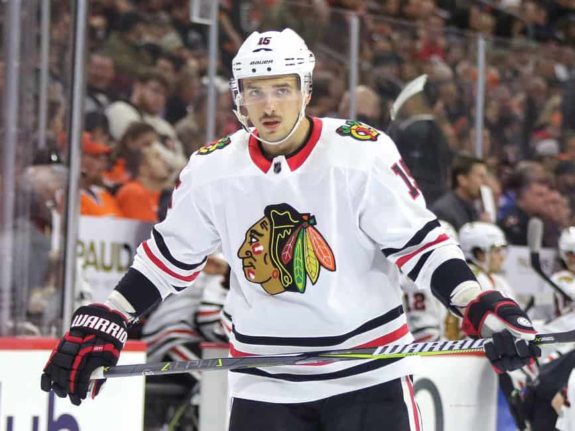
More so than supposed “balance,” the biggest offensive priority for the Blackhawks at this point might be finding a way to recreate a dominant line that they simply didn’t have last season. They’ve yet to recover from the breakup of the Kane-Anisimov-Panarin unit, one of the most productive in the NHL during its time together. Line balance isn’t helpful if all of the lines end up being mediocre or worse.
The Hawks will also have the opportunity to add scoring depth shortly through the free-agent market and trades, with their salary cap situation being considerably better this offseason than it has been in recent years, but their main focus needs to be doing what they can to revive the dynamic play of their two offensive pillars. An aggressive change of approach that sends a Kane-Toews pairing at opponents nightly might do the trick. Why not at least find out?
Not doing so and refusing to challenge their own long-held conventional thinking could again prove fatal to the Blackhawks’ playoff chances in 2018-19.
Note: Advanced statistics courtesy of naturalstattrick.com.